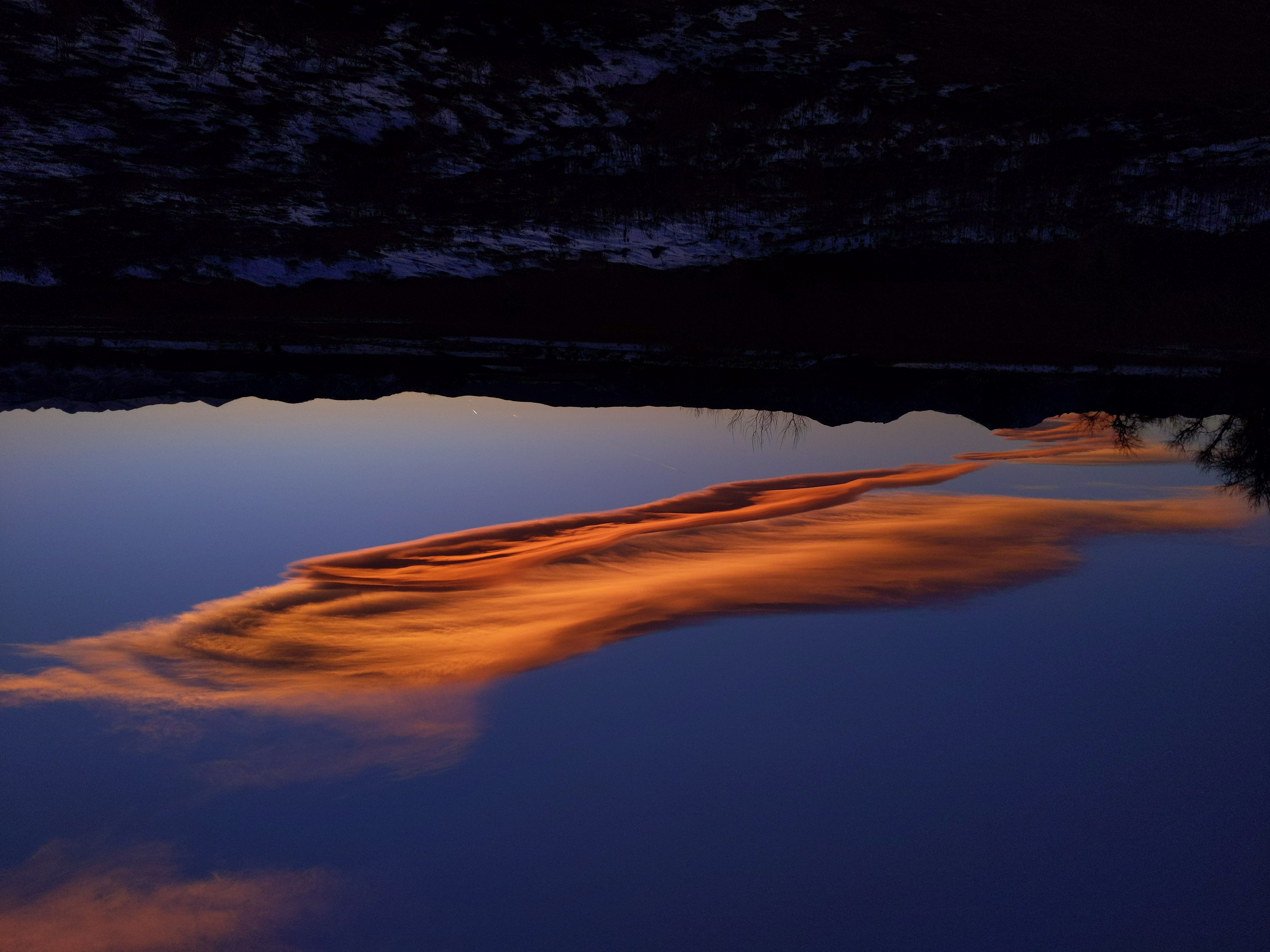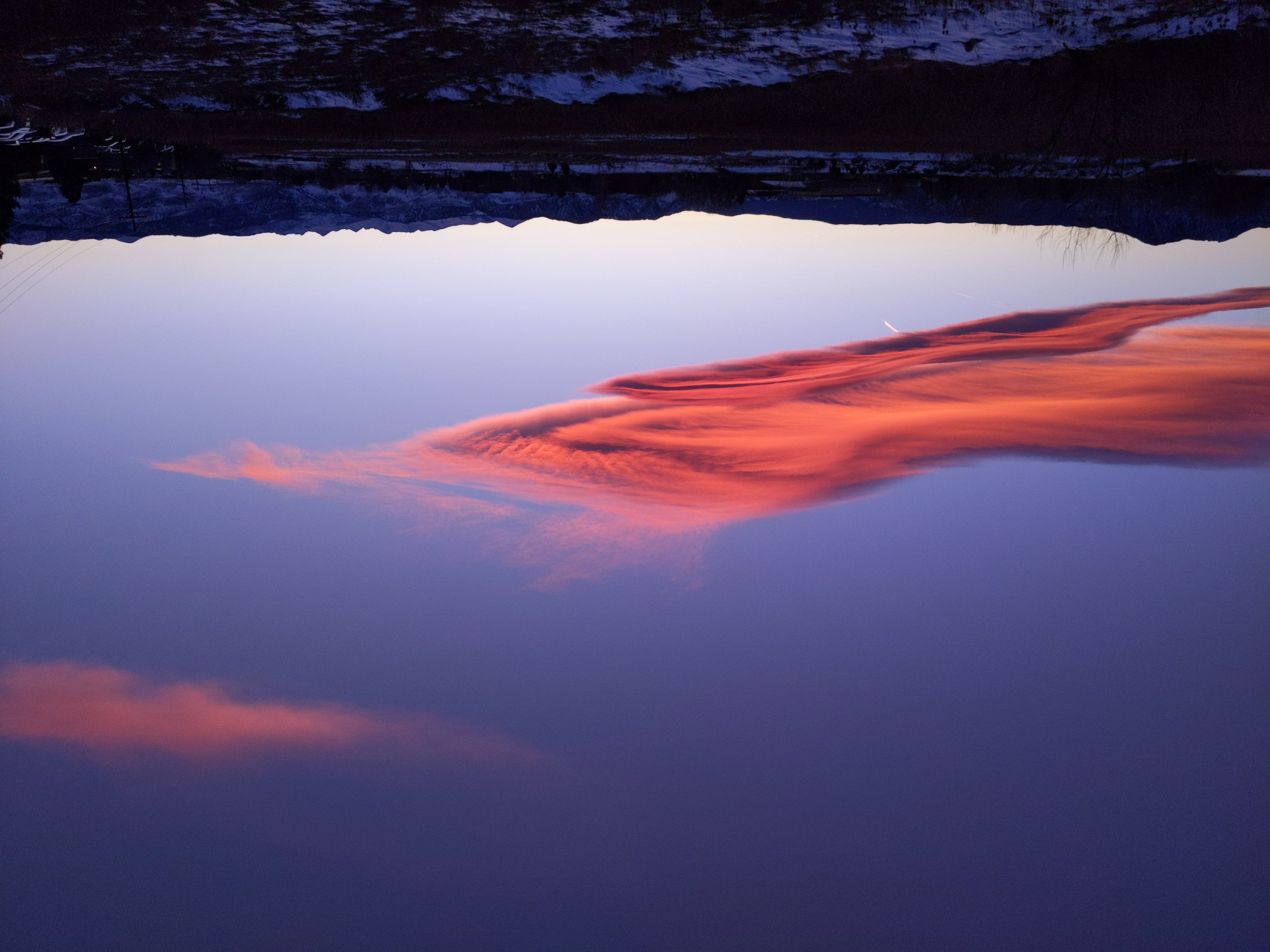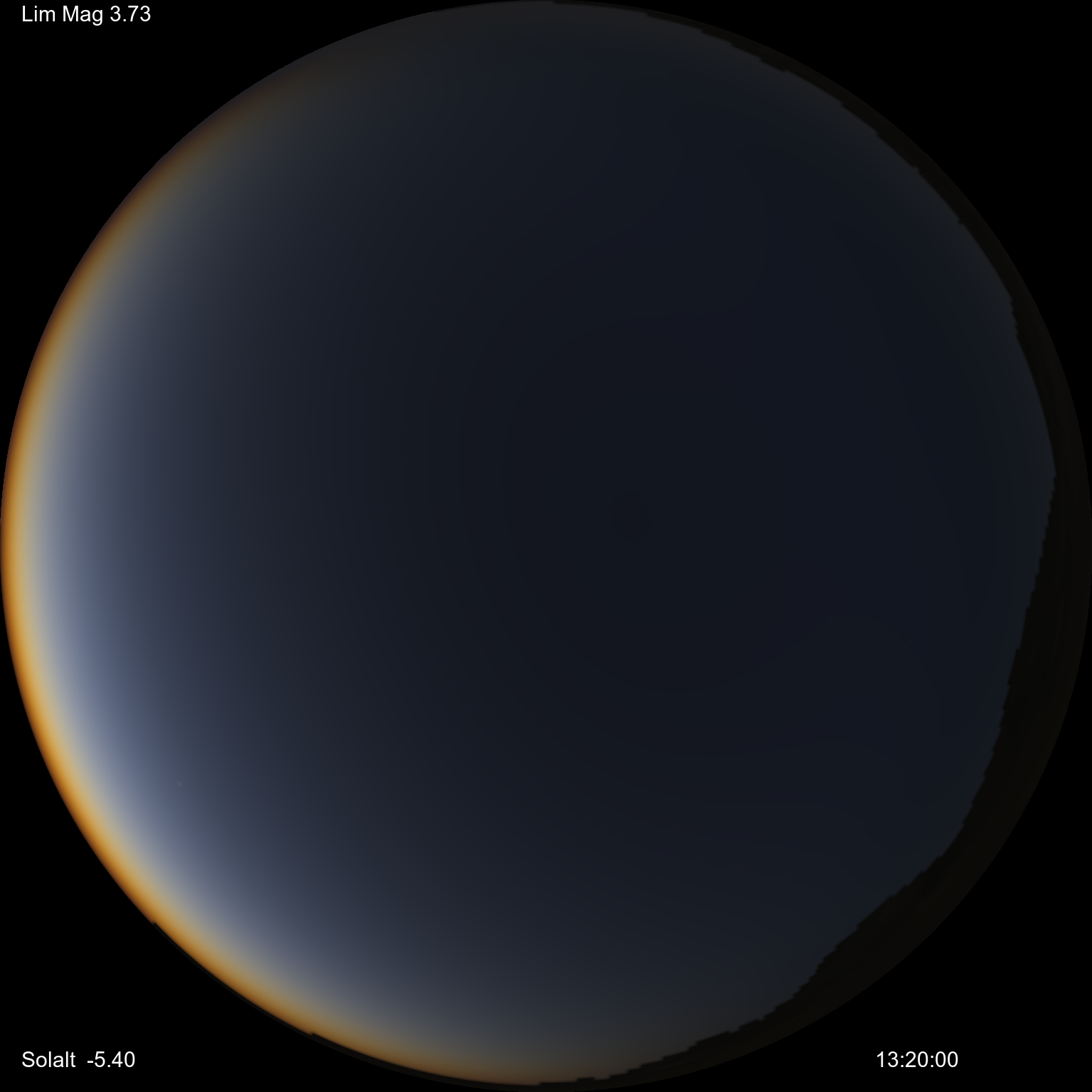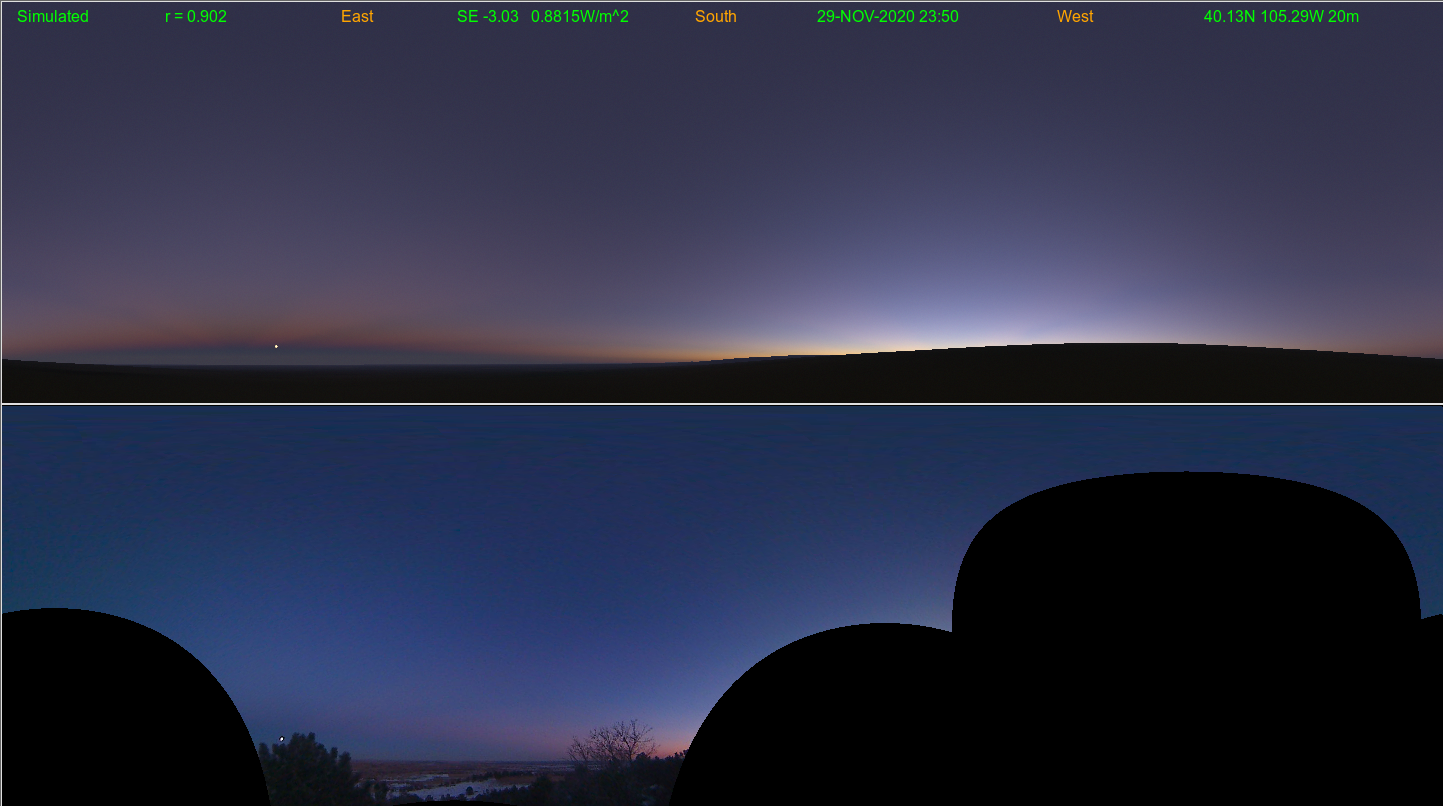

Introduction: Twilight and related phenomena can be appreciated as an intersection between science and art. The colors we see in particular parts of a clear sky during twilight are influenced by several factors. Light is scattered in the atmosphere by air molecules, clouds, and aerosols. Ozone absorption also plays a role. To anticipate what would be seen in a particular direction consider a line of sight extending from the observer (backward ray), a series of primary scattering points along the backward ray, and additional lines from each primary scattering point to the sun. The path of sunlight through the atmosphere to the primary scattering points (forward rays) is related to the solar elevation angle (SEA) and is negative when the sun is below the horizontal. What the observer sees is largely a summation of the light scattered at each primary scattering point.
Rayleigh scattering by air molecules has a strong wavelength dependence with blue scattering more. Aerosols have less dependence as their size increases and clouds have nearly none. Ozone absorbs mostly in the yellow/orange wavelengths of visible light. The scattering and absorption has the most effect on the grazing forward rays, except when looking near the horizon, when the backward rays also have a long path length.
Secondary (additional) scattering events generally subtract from the observed intensity along the line of sight, though can add to a diffuse glow seen in other directions.
Cloud colors: In the west (above left image) the mountain wave cloud is bright orange in this photo I took from Boulder in Februrary 2022. Six minutes later (right) the clouds become redder and the highest clouds on the right become slightly pink colored. Low altitude clouds show a sunset progression from yellow to orange to red as the sun moves further below the horizon. Rayleigh scattering imparts color to the sunlight illuminating the clouds becoming redder when the light path passes through the denser lower troposphere. The cloud colors are more vivid when there is low aerosol content allowing the Rayleigh scattering from gases (mainly N2 and O2) to dominate. Very high clouds have a somewhat different progression, going from yellow to orange to a slightly pink color. This coloration is due to ozone absorption (combined with attenuation from Rayleigh scattering) peaking in green wavelengths and letting through more red and blue to illuminate the clouds. Higher clouds have more of a light path going through the stratospheric ozone, relative to the Rayleigh scattering gases more dominant in the troposphere.
A sunrise simulation is shown above compared with a camera observation from Altona Colorado showing underlit clouds. Additional sunset photographs can be found on Les Cowley's Atmospheric Optics site. The underside of clouds tend to have the deepest reds when clouds are low, the sun is barely below the horizon, tropospheric aerosols are absent, and the viewer is at elevations near sea level.
Clear sky colors:
The twilight arch is the brighter area of sky above where the sun is located. The anti-twilight arch is a secondary area of slightly brighter sky above the Earth's shadow opposite the sun
and is usually more prominent in shallow twilight.
Clear sky twilight colors are influenced by gas and aerosols in both the troposphere and stratosphere. They relate to the gas component Rayleigh scattering (mostly red/yellow from the troposphere), aerosols throughout the atmosphere (high ones adding or low ones suppressing), and ozone (mainly in the stratosphere, lowering the intensity as per the idealized simulation shown below).
The red band right on the horizon with yellow just above are associated with Rayleigh scattering in clean and dense tropospheric air.
Any lower tropospheric aerosols present aren't illuminated by the sun and show up only via the attenuation and secondary scattering that they do, suppressing the colors, particularly low down in the twilight arch.
Higher altitude aerosols remain in the direct sunlight and perform a more additive role of increasing the colors, such that
the orange/yellow colors can become brighter and augmented with pink or purple above. The relevant altitude varies
and is above where the Earth's shadow is placed along the line of slight in the atmosphere at a particular stage of twilight.
At the zenith the height of the Earth's shadow in kilometers is roughly given by SEA2. The shadow is a large tilted cone such that this height decreases towards the sun and increases away from the sun.
This is generally in the upper troposphere or stratosphere (see the volcanic twilight example below). The pinkish colors generally show up above the Earth's shadow opposite the sun in shallow twilight (sun 0-3 degrees down), and shift to overhead or above the main twilight arch in mid twilight (sun 3-8 degrees down).
Note that cloud shadows, sometimes from clouds beyond the visible horizon, can suppress twilight colors, or if the clouds have breaks in them will give rise to crepuscular (or anticrepuscular) rays.
Earth's shadow:
Low in the east we can see the Earth's shadow framed on the top by the reddish band of the anti-twilight arch or "Belt of Venus". This belt represents mid-high level aerosols lit by the setting sun.
Note the Earth's shadow can be a bit higher than expected (even visible just prior to sunset) due to several factors:
1) Instead of the Earth's limb, we are seeing the shadow of the lower atmosphere, clouds, or higher terrain to the west. In this simulation the lower atmospheric extinction is the main factor. 2) One can also see "extra" Earth's shadow when on a more isolated mountain top and the horizon shows up at a depressed angle.
In the example below we see (simulated and observed from Altona Colorado) the full moon rising with the Earth's shadow and the Belt of Venus. Also visible are some anticrepscular rays, shadows cast by distant clouds below the western horizon.
The ray-tracing
algorithm includes the scattering by N2 and O2, as well as absorption by ozone.
The ozone contribution adds significantly to the blue sky color near the zenith during
early twilight, otherwise it would be more grayish.
Later in twilight with the sun lower than this elevation,
secondary scattering predominates near the zenith and thus Rayleigh scattering once again has more effect.
Evening twilight simulation with an SEA of -3.3 degrees.
The twilight arch is visible with a gradient of intensity and colors
as we near the western horizon.
Recently in Colorado I've noticed enhanced purple colors in the twilights that are likely stratopheric (or upper tropospheric) aerosols from a recent volcano or some other
type of sulfate pollution. One candidate would be Calbuco that erupted in Chile in April, 2015. This is reminiscent of the volcanic twilights of the 1980s and 1990s though more moderate in intensity. The simulated sky is modeled
by considering an additional (mainly) stratospheric aerosol layer from 13-25km high having an optical depth of .026, uniformly distributed within this vertical layer. This reasonably matches my visual impression of recent sunsets, though the all-sky camera has a tendency to wash out the colors.
The photo below was taken on the evening of September 20, 2015 with a regular digital camera and shows the volcanic twilight colors more clearly.
The mountains cut off the view within about 3 degrees of the horizon.
More on volcanic twilights is here.
Above is a deeper twilight view from a rural mountain location with the sun about 13 degrees below the horizon. We see the twilight arch low in the west, along with zodiacal light, the crescent moon, and airglow. Here is an
animation over time. The earthshine visible on the dark side of the moon is still somewhat empirical.
To see the zodiacal light and stars with the best contrast try turning up the brightness setting on your monitor.
Above is a cropped twilight view from a rural mountain location with the sun about 15 degrees below the horizon.
We see the twilight arch low in the west along with zodiacal light and airglow.
This version has improved secondary twilight handling, so we see a gradually diminishing glow above the primary twilight arch.
To see the zodiacal light and stars with the best contrast try turning up the brightness setting on your monitor.
A nighttime simulated view (left) in a rural location includes stars from the Gaia Catalogue, and other aspects of the night sky compared with a camera image (right).
Here are live nighttime sky simulations at two rural observatories including
Dark Sky New Mexico and Solar Hills Observatory.
Effects of clouds, aerosols, airglow, moonlight, and city lights are included.
The above simulated image shows city lights from Denver scattering off of clouds on a snowy night as seen from between Boulder and Longmont, Colorado.
The moon is also shown filtering through the icy clouds.
For city lights we can consider a variety of situations such as distant light domes with clear dark skies in rural locations or more local lights reflecting off of clouds.
The sources of these artifical lights at night (ALAN) are taken from a static 700m resolution global map developed from the VIIRS polar orbiting satellite instrument. Aerosols are treated with single scattering
at each grid box using a phase angle associated with the mean direction of the lights reaching that grid box.
A 3D field of both upward and scalar spectral irradiance is calculated at each grid box with an approximate evaluation of an integral of the illumination from each surface grid box for the 3D grid volume in question. The scalar irradiance is useful for the single scattering calculation involving the gas and aerosols while the upward irradiance is useful to evaluate the radiance of the cloud component.
Cloud scattering is treated as Lambertian with a consideration of their opacity. This approach has some similarities to a more complex model published by Roy Garstang.
At night we're now using a real-time aurora model forecast that is updated on a sub-hourly basis. Data from the NOAA/SPWC Ovation model is utilized to derive 3D aurora spectral radiance information for projecting into the viewer perspective.
There are opportunities to compare the simulations with several types of observations in visible light.
This includes ground-based camera images, ground-based photometers, as well as images and radiances from realtime VIIRS measurements.


Click above images for twilight sequence animations. Polar and cylindrical animations are every
5 minutes and represent clear sky only without clouds.
Various aspects of twilight are visible, including the Earth/atmosphere shadow and Belt of Venus opposite the sun shortly before sunrise.
Stellar limiting magnitude at the zenith is listed, and assumes a moderate amount of skyglow due to artificial lighting. These are intentionally "underexposed" so we
avoid distorting the colors in bright areas due to saturation. It can help to turn up your monitor brightness to see the best view.
Some artifacts that are present from the process of making the animated GIFs can be avoided by looking at
the individual cylindrical and polar frames, while others stem from the model grid boxes that are used when clouds are present and crepuscular rays are being simulated.



We can see in the above two images the effect of ozone with the sun 3 degrees above the horizon. Surface pressure is 850mb with no aerosols. Top has no ozone and bottom has 300DU of ozone.
Only Rayleigh scattered light is shown so the sun itself and the localized glow around the sun (aureole) are invisible.
The overhead sky would turn a paler blue when the sun is near or below the horizon, though ozone saves the evening by keeping the zenith sky a deeper blue.
The bottom frame may have too bright of a yellow hue around 3 degrees above the horizon, though this can be reduced by apportioning more of the ozone in the troposphere (not shown).
Generally about 10% of the ozone mass is in the troposphere though this could increase in polluted areas.
Increasing the spectral resolution in the ray-tracing algorithm might also help.
More on Night Sky